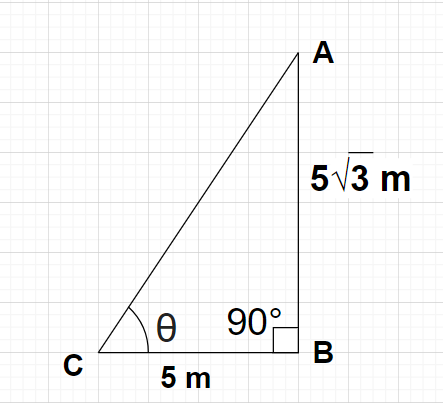
A tower is $5\sqrt 3 $ meter high. Find the angle of elevation of its top from a point 5 meter away from its foot.


Answer
590.7k+ views
Hint- Here, we will be making diagram according to the problem statement and then we will use the formula for tangent trigonometric function i.e, $\tan \theta = \dfrac{{{\text{Perpendicular}}}}{{{\text{Base}}}}$ in order to evaluate the value for the angle of elevation (i.e., $\theta $).
Complete step-by-step answer:
Given, height of the tower AB = $5\sqrt 3 $ meter
Let point C be a point which is 5 meter away from the foot of the tower AB (i.e., point B).
Let us suppose that the angle of elevation of the top of the tower (i.e., point A) from point C is $\theta $.
As we know that in any right angled triangle, $\tan \theta = \dfrac{{{\text{Perpendicular}}}}{{{\text{Base}}}}{\text{ }} \to {\text{(1)}}$
In the right angled triangle ABC (right angled at vertex B), side AB is the perpendicular, side BC is the base and side AC is the hypotenuse.
Using formula given by equation (1) for triangle ABC, we get
$
\tan \theta = \dfrac{{{\text{AB}}}}{{{\text{BC}}}} = \dfrac{{5\sqrt 3 }}{5} \\
\Rightarrow \tan \theta = \sqrt 3 {\text{ }} \to {\text{(2)}} \\
$
Also we know that $\tan {60^0} = \sqrt 3 {\text{ }} \to {\text{(3)}}$
Clearly, the RHS of both the equations (2) and (3) is the same so the LHS of both these equations will also be equal.
i.e., $
\tan \theta = \tan {60^0} \\
\Rightarrow \theta = {60^0} \\
$
Therefore, the required angle of elevation of the top of the tower from a point 5 meter away from the foot of the tower is ${60^0}$.
Note- In any right angled triangle, the hypotenuse is the side opposite to ${90^0}$ (in this case the right angle is at B and the side opposite to vertex B is AC), the perpendicular is the side opposite to the considered angle $\theta $ (in this case the perpendicular is AB) and the base is the remaining side (in this case base is BC).
Complete step-by-step answer:
Given, height of the tower AB = $5\sqrt 3 $ meter
Let point C be a point which is 5 meter away from the foot of the tower AB (i.e., point B).
Let us suppose that the angle of elevation of the top of the tower (i.e., point A) from point C is $\theta $.
As we know that in any right angled triangle, $\tan \theta = \dfrac{{{\text{Perpendicular}}}}{{{\text{Base}}}}{\text{ }} \to {\text{(1)}}$
In the right angled triangle ABC (right angled at vertex B), side AB is the perpendicular, side BC is the base and side AC is the hypotenuse.
Using formula given by equation (1) for triangle ABC, we get
$
\tan \theta = \dfrac{{{\text{AB}}}}{{{\text{BC}}}} = \dfrac{{5\sqrt 3 }}{5} \\
\Rightarrow \tan \theta = \sqrt 3 {\text{ }} \to {\text{(2)}} \\
$
Also we know that $\tan {60^0} = \sqrt 3 {\text{ }} \to {\text{(3)}}$
Clearly, the RHS of both the equations (2) and (3) is the same so the LHS of both these equations will also be equal.
i.e., $
\tan \theta = \tan {60^0} \\
\Rightarrow \theta = {60^0} \\
$
Therefore, the required angle of elevation of the top of the tower from a point 5 meter away from the foot of the tower is ${60^0}$.
Note- In any right angled triangle, the hypotenuse is the side opposite to ${90^0}$ (in this case the right angle is at B and the side opposite to vertex B is AC), the perpendicular is the side opposite to the considered angle $\theta $ (in this case the perpendicular is AB) and the base is the remaining side (in this case base is BC).
Recently Updated Pages
The height of a solid metal cylinder is 20cm Its r-class-10-maths-ICSE

If a train crossed a pole at a speed of 60kmhr in 30 class 10 physics CBSE

Name the Writs that the High Courts are empowered to class 10 social science CBSE

A tower is 5sqrt 3 meter high Find the angle of el-class-10-maths-CBSE

Immediate cause of variations of A Mutations B Environmental class 10 biology CBSE

A rectangular container whose base is a square of side class 10 maths CBSE

Trending doubts
Why is there a time difference of about 5 hours between class 10 social science CBSE

Why is Sardar Vallabhbhai Patel called the Iron man class 10 social science CBSE

Tropical deciduous trees shed their leaves in the dry class 10 social science CBSE

The Equation xxx + 2 is Satisfied when x is Equal to Class 10 Maths

Write a letter to the principal requesting him to grant class 10 english CBSE

Leap year has days A 365 B 366 C 367 D 368 class 10 maths CBSE




